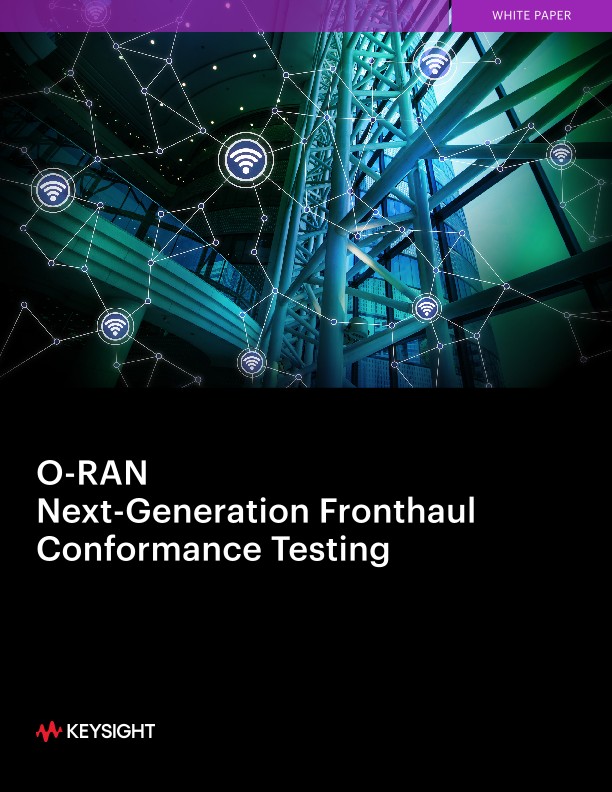
O-RAN Next-Generation Fronthaul Conformance Testing
白皮书
The Move Toward an Open RAN
Radio access network (RAN) deployments for 4G and earlier relied on shared proprietary network equipment from the same vendor or vendors. Traditionally a multi-vendor network had equipment from multiple vendors deployed in different parts of the network. Most often, equipment from various vendors did not mix in a particular part of the multi-vendor network. Many service providers refer to this as a single vendor “region.” As a result, the radio units had to be from the same manufacturer as the baseband unit (BBU). Together, these devices formed what was known as the eNodeB (eNB) in LTE.
Driven mainly by the O-RAN Alliance, service providers worldwide are driving adoption of an open RAN for 5G. The O-RAN Alliance has defined a 5G RAN architecture that breaks down what was once a single-vendor, hardware-centric RAN into several sections. Interoperable standards precisely define the interfaces between these sections.
As a result, service providers can mix and match components from several vendors, which offers the following benefits:
- Virtualization: Fronthaul interfaces are moving from proprietary common public radio interface (CPRI) to open Ethernet. Ethernet enables virtualization by allowing fronthaul traffic to switch between physical nodes using common off-the-shelf networking equipment. As a result, traffic directs to nodes with spare capacity and new instances of baseband processing startup.
- Price: Competition within the marketplace reduces costs.
- Innovation: Previously, small-scale radio vendors could not gain entry to a network because they did not interoperate with an incumbent eNB. Service providers were unable to deploy any breakthrough technology offered by a small-scale vendor unless they also used that vendor’s eNB. Small vendors lack the resources to build a complete RAN. Open interfaces solve this problem.
- Speed of innovation: Small-scale companies move faster than large ones. By enabling these companies to participate, carriers hope to accelerate innovation.
- More control: Virtualization of new network elements allow for more customization without proprietary interfaces.
The new O-RAN for 5G, and in many cases retroactively for LTE, consists of the following three components:
- O-RAN Central Unit (O-CU) is the component of the RAN that is centralized and virtualized. It is responsible for the packet data convergence protocol (PDCP) layer of the protocol. Its northbound interface is the backhaul network to the core; its southbound interface is the F1 interface.
- O-RAN Distributed Unit (O-DU) is the component responsible for all baseband processing, scheduling, radio link control (RLC), medium access control (MAC), and the upper part of the physical layer (PHY). The F1 is the northbound interface, and the O-RAN fronthaul is the southbound interface. The virtualization of this component is typical but requires some hardware assistance in the form of accelerators such as field-programmable gate arrays (FPGAs) or graphics processing units (GPUs).
- O-RAN Radio Unit (O-RU) is the component responsible for the lower part of the PHY layer processing (for example, fast Fourier transform (FFT) / inverse fast Fourier transform (IFFT), beamforming), including the analog components of the radio transmitter and receiver. There is a remote possibility of virtualization of the O-RU; however, one working group in the O-RAN Alliance plans a “white box” radio implementation using off-the-shelf components. It enables anyone to construct a radio without proprietary components, which differs from virtualization.
Conformance and Interoperability
Testing Making the new open RAN work demands stringent test requirements. In the past, testing the eNB as a complete entity according to 3GPP requirements was enough. The required test points focused on the UE and backhaul interface. With the introduction of the open RAN and a distributed RAN, it is now necessary to test each component in isolation for conformance to the standards. It is also important to test the components in combinations for interoperability.
Benefits of conformance test
- Stresses the device under test (DUT) to the limits of its stated capabilities.
- Exercises protocol features to test that interfaces and functions are working as expected.
- Ensures your application is functioning properly by performing negative testing, which is not possible in interoperability testing.
Test Challenges
- Fronthaul conformance testing: Interoperability testing methodology changed minimally from 4G to 5G O-RAN. In interoperability testing, you simply test a combination of equipment as a gNB, similar to testing an eNB in 4G. Conformance testing is different for O-RAN conformance tests.
- Conformance test for the O-DU: The master node for the O-RAN fronthaul protocol is the O-DU. In the O-DU southbound interface, the control and user plane protocol messages come from the O-DU to the O-RU, except license assisted access (LAA) and uplink user plane data. The O-RU does not acknowledge these messages; it merely carries them out in the best feasible way.
- Conformance test for the O-RU : The O-RU executes C-plane commands without acknowledgment back to the O-DU. These messages transmit at extremely high data rates and a very tight timing tolerance. You can analyze the RF response of the O-RU to determine whether it understood and correctly acted on the O-DU’s commands. Also, to test the O-RU, you need an emulator to simulate the O-DU, a vector signal analyzer to receive RF energy emitted by the O-RU, and a signal source to generate an uplink signal to the O-RU for it to process. You need additional equipment such as a chamber and positioning system if this is for an over-the air (OTA) test.